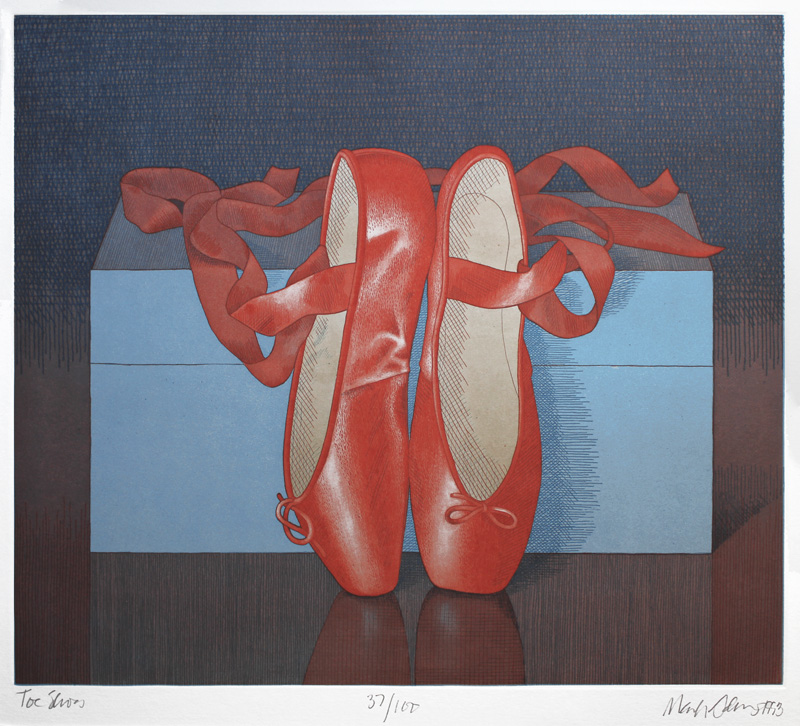Toe Shoes is an etching and aquatint printed in colors from 1993 by American artist Mark Adams. It is pencil signed, titled, dated, and editioned 37/100. Beyond the edition there were ten artist’s proofs. Toe Shoes was printed by David Kelso at Teaberry Press on ivory BFK Rives wove paper and it was published by the artist to benefit the San Francisco Ballet Association. The platemark measures 13-1/6 x 15-1/16
Adams presents an intimate still life of ballerina pointe shoes seemingly just unboxed. According to the Pittsburg Ballet Theatre, point shoes sometimes last for only one performance depending upon the difficulty of the ballet. The tip of the shoe is a rigid box made of densely packed layers of fabric, cardboard, and or paper hardened by glue and the rest of the shoe is made of leather, cotton, and satin. New shoes have to be broken in before being worn and some methods include darning the platform of the box to provide traction and prevent the satin from fraying, pounding the box of the shoe with a hammer to soften it, opening and closing a door on the box, cutting the satin off the box and using a carpenter's file to rough up the sole, and lining the inside of the box with floor way or shellac to mold the shoes and prolong wear. The satin ribbon, while beautiful, is necessary to hold the shoe in place.
Mark Adams, watercolorist, printmaker, mosaicist, and tapestry artist, was born on 27 October 1925 in Fort Plain, New York. He studied at the School of Fine Arts, Syracuse University between 1943 and 1945 but left before graduation to study painting in New York at the Hans Hofmann School of Fine Arts. While in New York, he also studied at Stanley William Hayter’s Atelier 17.
In 1946, Adams traveled to Carmel, California to assist Harry Downie on the restoration of the Carmel Mission. Adams dug ditches for the project until his training came to light and he was asked to paint the stations of the cross in one of the chapels. The following year he returned to New York to resumed studies with Hans Hofmann.
Adams returned to California in 1948 settling in San Francisco and worked for Gump’s department store in San Francisco in window display design and then worked freelance as a commercial display designer. Adams was drawn to tapestry after visiting the Cloisters and tapestry collections of the Metropolitan Museum of Art and begins his first tapestry design in 1952. Adams’ first solo exhibition was mounted at Gump’s in 1954. He apprenticed himself for four months with Jean Lurçat at his atelier in a chateau above Saint-Céré, France in 1955. He then studied at L’École Nationale d’Art Décoratif in Aubusson, France, where he met master weaver Paul Avignon who would eventually weave over one hundred of Adams’ tapestry designs.
According to the San José Museum of Art, “Adams played a pivotal role in the Bay Area fiber art renaissance of the 1960s through the 1980s. Of note, he was commissioned by the Fine Arts Museum of San Francisco to design a tapestry that was woven as an educational feature of their landmark exhibition Five Centuries of Tapestry in 1976. This project became the catalyst for the formation of the San Francisco Tapestry Workshop, a weaving atelier and school that produced many of Adam’s tapestry commissions as well as tapestries for Judy Chicago’s Dinner Party project. Three generations of contemporary tapestry artists have been greatly influenced by Adam’s legacy of technique, composition and exquisite color.”
After two decades of designing tapestries and stained-glass windows and numerous exhibitions, Adams turned to watercolor in 1976. A medium both immediate and intimate.
Adams’ large-scale commissions can be viewed in San Francisco at Temple Emanu-El, Grace Episcopal Cathedral and at the International Terminal of the San Francisco International Airport.
His work is represented in the permanent collections of the Monterey Museum of Art, California; the Oakland Museum of California; the Portland Art Museum, Oregon; the Racine Art Museum, Wisconsin; the San Francisco Museums of Fine Arts, California; the San José Museum of Art, California; and the Stanford Library of Art and Architecture, California.
Mark Adams died in San
Francisco on 24 January 2006.



